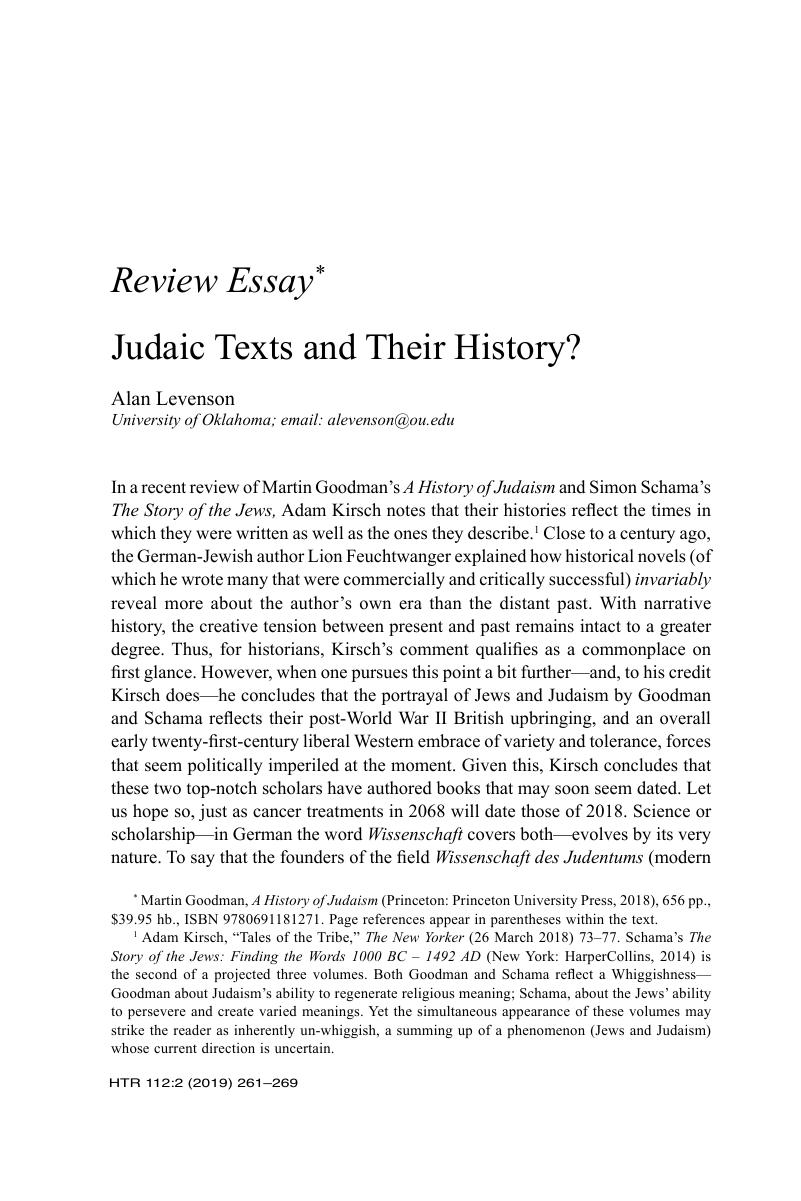No CrossRef data available.
Article contents
Judaic Texts and Their History?
Published online by Cambridge University Press: 15 April 2019
Abstract

- Type
- Review Essay
- Information
- Copyright
- Copyright © President and Fellows of Harvard College 2019
Footnotes
Martin Goodman, A History of Judaism (Princeton: Princeton University Press, 2018), 656 pp., $39.95 hb., ISBN 9780691181271. Page references appear in parentheses within the text.
References
1 Kirsch, Adam, “Tales of the Tribe,” The New Yorker (26 March 2018) 73–77Google Scholar. Schama’s The Story of the Jews: Finding the Words 1000 BC – 1492 AD (New York: HarperCollins, 2014) is the second of a projected three volumes. Both Goodman and Schama reflect a Whiggishness— Goodman about Judaism’s ability to regenerate religious meaning; Schama, about the Jews’ ability to persevere and create varied meanings. Yet the simultaneous appearance of these volumes may strike the reader as inherently un-whiggish, a summing up of a phenomenon (Jews and Judaism) whose current direction is uncertain.
2 Batnitzky, Leora, How Judaism Became a Religion: An Introduction to Modern Jewish Thought (Princeton: Princeton University Press, 2011)Google Scholar; Collins, John J., The Invention of Judaism: Torah and Jewish Identity from Deuteronomy to Paul (Berkeley: University of California Press, 2017CrossRefGoogle Scholar).
3 Leopold Zunz’s Synagogue Poetry in the Middle Ages [Die synagogale Poesie des Mittelalters] (Berlin, Julius Springer, 1855). I use the translation of George Eliot, who took these lines as an epigraph to chapter 42 of her proto-Zionist novel Daniel Deronda (Edinburgh: Blackwood, 1876).
4 Mendes-Flohr, Paul and Reinharz, Jehuda, The Jew in the Modern World: A Documentary History (3rd ed.; Oxford: Oxford University Press, 2011Google Scholar).
5 Schiffman, Lawrence, From Text to Tradition: A History of Second Temple and Rabbinic Judaism (Hoboken, NJ: KTAV 1991Google Scholar).
6 Abraham Geiger, Das Judentum und seine Geschichte (Breslau, W. Jacobsohn, 1910).
7 Baron, Salo, Social and Religious History (New York: Columbia University Press, 1993Google Scholar).
8 Efron, John, Weitzman, Steven, and Lehmann, Matthias, The Jews: A History (2nd ed.; New York: Routledge, 2014Google Scholar).
9 Seltzer, Robert, Jewish People, Jewish Thought: The Jewish Experience in History (London: Macmillan, 1980Google Scholar).
10 Biale, David (ed.), Cultures of the Jews: A New History (New York: Schocken Books, 2002Google Scholar).
11 Brilliant as Simon Schama is, his first two volumes do not evidence the decades-long immersion in secondary sources so evident in Goodman’s history, nor does Schama offer new scholarly directions as does Biale’s Cultures of the Jews. As above, this reflects my assessment of the maturation of the field of Jewish studies, not a criticism of Schama’s readable work.




